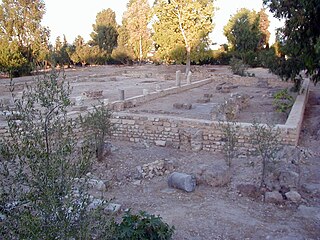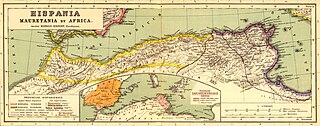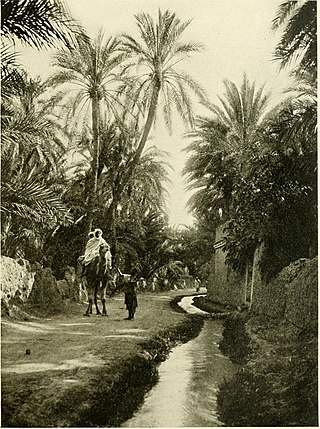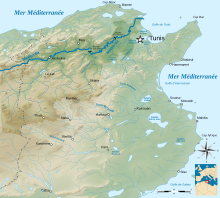
Assuras, sometimes given as Assura or Assur, was a town in the Roman province of Proconsular Africa.

Quiza also known as Vuiza (Βούϊζα), which Pliny the Elder called Quiza Xenitana, was a Roman–Berber colonia, located in the former province of Mauretania Caesariensis. The town is identified with ruins at Sidi Bellater, Algiers.

The Archdiocese of Carthage, also known as the Church of Carthage, was a Latin Catholic diocese established in Carthage, Roman Empire, in the 2nd century. Agrippin was the first named bishop, around 230 AD. The temporal importance of the city of Carthage in the Roman Empire had previously been restored by Julius Caesar and Augustus. When Christianity became firmly established around the Roman province of Africa Proconsulare, Carthage became its natural ecclesiastical seat. Carthage subsequently exercised informal primacy as an archdiocese, being the most important center of Christianity in the whole of Roman Africa, corresponding to most of today's Mediterranean coast and inland of Northern Africa. As such, it enjoyed honorary title of patriarch as well as primate of Africa: Pope Leo I confirmed the primacy of the bishop of Carthage in 446: "Indeed, after the Roman Bishop, the leading Bishop and metropolitan for all Africa is the Bishop of Carthage."
Musti in Numidia, also called Musti Numidiae, was an ancient city and bishop jurisdiction (bishopric), and is presently a Catholic titular see,(bishop's government see of a former government under a church's responsibility, also known as a dead diocese.) in modern Algeria.

Vazari-Didda or Vazari Didda) was an Ancient city and bishopric in Roman Africa, which remains a Latin Catholic titular see.
Nicives, identifiable with N'Gaous in Batna Province, Algeria, was an ancient Roman town of the Roman province of Numidia.

Mutugenna or Muttegena was a colonia (town) of the Roman, Berber and Vandal empires, located in the Maghreb. The city is generally identified with the ruins at Ain-Tebla in modern Algeria. Mutugenna was also the locus of a bishopric and was an important site in the development of the Donatist schism.

Sétifis, was a Romano town located in northeastern Algeria. It was the capital of the Roman province called Mauretania Sitifensis, and it is today Setif in the Sétif Province (Algeria).
Zattara was an ancient Roman and Byzantine town in the Africa province. It was located in present-day Kef ben-Zioune, south-east of Calama, Algeria. The city was a titular see of the Roman Catholic Church.

Vescera, also known as Ad Piscinam, was an ancient titular see and Roman colony in Roman North Africa. It has been identified as a site near Biskra in Algeria. It remains as a titular see of the Roman Catholic Church in the Province of Numidia.

Gaguari is a former diocese of North Africa and since 1933 a titular bishopric. The location of the former diocese is for the moment unknown. Under Roman hegemony, the bishop belonged to the province of Byzacène. This province was located in North Africa. The exact location of Gaguari can not be determined for the current state of research. However, everything leads us to believe that the bishopric site localizes to the current Sahel of Tunisia.

Bagai was a Roman–Berber city in the province of Africa Proconsularis. It must have been of some reasonable size, as it was also the seat of an ancient Catholic bishopric. The ancient city has been identified with ruins at Ksar-Bagaï outside of Baghai, in the Aurès Mountains of the El Hamma District in Khenchela Province, Algeria.

The Diocese of Sinnuara is a sede soppressa and titular see of the Roman Catholic Church. The bishopric is suffragan to the Archdiocese of Carthage.

The Diocese of Bennefa is a home suppressed and titular see of the Roman Catholic Church. Bennefa, identifiable with Oglet-Khefifa in modern Tunisia, is an ancient civitas of the Roman province of Byzacena. and a seat of an ancient Christian episcopal see. The diocese was mentioned by Augustine of Hippo.
Cabarsussi, was an ancient civitas (municipality) and bishopric in the Roman province of Byzacena, that is tentatively identifiable with ruins at Drâa-Bellouan in modern Tunisia. The current bishop is Terence Robert Curtin, auxiliary bishop of Melbourne.

Numida was an ancient Roman town in the Roman province of Mauretania Caesariensis. It was located in modern northern Algeria.
The diocese of Betagbarar is a suppressed and now titular see of the Roman Catholic Church.
Sicilibba was an ancient Roman town of the Roman province of proconsular Africa. The ancient town is tentatively identifiable with the ruins at Alaouine in today's Tunisia.

The diocese of Rufiniana is a suppressed and titular bishopric of the Roman Catholic Church.

The Diocese of Zella is a suppressed and titular see of the Roman Catholic Church.









